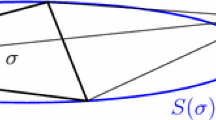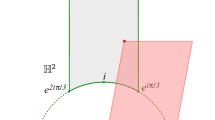Abstract
We give a definition of the Delaunay triangulation of a point set in a closed Euclidean d-manifold, i.e. a compact quotient space of the Euclidean space for a discrete group of isometries (a so-called Bieberbach group or crystallographic group). We describe a geometric criterion to check whether a partition of the manifold actually forms a triangulation (which subsumes that it is a simplicial complex). We provide an incremental algorithm to compute the Delaunay triangulation of the manifold defined by a given set of input points, if it exists. Otherwise, the algorithm returns the Delaunay triangulation of a finite-sheeted covering space of the manifold. The algorithm has optimal randomized worst-case time and space complexity. It extends to closed Euclidean orbifolds. An implementation for the special case of the 3D flat torus has been released in Cgal 3.5. To the best of our knowledge, this is the first general result on this topic.











Similar content being viewed by others
Notes
The number of Bieberbach groups by dimension is assigned the id A006227 in the On-Line Encyclopedia of Integer Sequences [44]. The number of torsion-free Bieberbach groups is assigned the id A059104.
We skip the technicalities of the initialization of the triangulation with the first point of \({\mathcal {P}}\).
Using the random point generator from Cgal to generate uniformly distributed points in a cube.
References
Alliez, P., Rineau, L., Tayeb, S., Tournois, J., Yvinec, M.: 3D mesh generation. In: CGAL User and Reference Manual. CGAL Editorial Board. http://doc.cgal.org/latest/Manual/packages.html#PkgMesh_3Summary
Armstrong, M.A.: Basic Topology. Springer, Berlin (1982)
Bernauer, J.: Computational structural biology: periodic triangulations for molecular dynamics. Talk at the workshop ‘Subdivide and tile’ (2009) http://www.lorentzcenter.nl/lc/web/2009/357/info.php3?wsid=357
Bieberbach, L.: Über die Bewegungsgruppen des \(n\)-dimensionalen euklidischen Raumes mit einem endlichen Fundamentalbereich. Gött. Nachr. 1910, 75–84 (1910). https://eudml.org/doc/58754
Bogdanov, M., Teillaud, M., Vegter, G.: Delaunay triangulations on orientable surfaces of low genus. In: Proceedings of the Thirty-second International Symposium on Computational Geometry (2016). https://hal.inria.fr/hal-01276386
Boileau, M., Maillot, S., Porti, J.: Three-Dimensional Orbifolds and Their Geometric Structures. Société Mathémathique de France, Paris (2003)
Boissonnat, J.-D., Yvinec, M.: Algorithmic Geometry. Cambridge University Press, Cambridge (1998). Translated by Hervé Brönnimann, http://www.cup.cam.ac.uk/Scripts/webbook.asp?isbn=0521563224
Boulch, A., de Verdière É.C., Nakamoto, A.: Irreducible triangulations of surfaces with boundary. Graphs Comb. 29(6), 1675–1688 (2013). Also in arXiv:1103.5364
Bowyer, Adrian: Computing Dirichlet tessellations. Comput. J. 24, 162–166 (1981)
Brakke, K.A., Sullivan, J.M.: Using symmetry features of the surface evolver to study foams. In: Hege, H.-C., Polthier, K. (eds.) Visualization and Mathematics: Experiments, Simulations and Environments, pp. 95–118. Springer, Berlin (1997). http://portal.acm.org/citation.cfm?id=270122.270129
Campayo, D.D.: Sklogwiki—Boundary Conditions. http://www.sklogwiki.org/SklogWiki/index.php/Boundary_conditions
Caroli, M.: Triangulating Point Sets in Orbit Spaces. Thèse de doctorat en sciences, Université de Nice-Sophia Antipolis, France (2010). http://tel.archives-ouvertes.fr/tel-00552215/
Caroli, M., Teillaud, M.: 3D periodic triangulations. In: CGAL User and Reference Manual. CGAL Editorial Board. http://doc.cgal.org/latest/Manual/packages.html#PkgPeriodic3Triangulation3Summary
Caroli, M., Teillaud, M.: Video: On the computation of 3D periodic triangulations. In: Proceedings of the Twenty-Fourth Annual Symposium on Computational Geometry, pp. 222–223 (2008). http://www.computational-geometry.org/SoCG-videos/socg08video/
Caroli, M., Teillaud, M.: Computing 3D periodic triangulations. In: Proceedings of the 17th European Symposium on Algorithms. Lecture Notes in Computer Science. vol. 5757, pp. 37–48 (2009). http://hal.inria.fr/inria-00356871/
Caroli, M., Teillaud, M.: Delaunay triangulations of point sets in closed Euclidean \(d\)-manifolds. In: Proceedings of the Twenty-Seventh Annual Symposium on Computational Geometry, pp. 274–282 (2011). https://hal.inria.fr/hal-01101094
CGAL: Computational Geometry Algorithms Library. http://www.cgal.org
Chossat, P., Faugeras, O.: Hyperbolic planforms in relation to visual edges and textures perception. PLoS Comput. Biol. 5(12):e1000625 (2009). https://hal.inria.fr/hal-00807344
Chossat, P., Faye, G., Faugeras, O.: Bifurcation of hyperbolic planforms. J. Nonlinear Sci. 21(4):465–498 (2011). https://hal.inria.fr/hal-00807355
de Berg, M., van Kreveld, M., Overmars, M., Schwarzkopf, O.: Computational Geometry: Algorithms and Applications, 2nd edn. Springer, Berlin (2000)
Delage, C., Devillers, O.: Spatial sorting. In: CGAL User and Reference Manual. CGAL Editorial Board. http://doc.cgal.org/latest/Manual/packages.html#PkgSpatialSortingSummary
Devillers, O.: The Delaunay hierarchy. Int. J. Found. Comput. Sci. 13, 163–180 (2002)
de Fabritiis, G., Coveney, P.V.: Dynamical geometry for multiscale dissipative particle dynamics. http://xxx.lanl.gov/abs/cond-mat/0301378v1 (2003)
Dolbilin, N.P., Huson, D.H.: Periodic Delone tilings. Period. Math. Hung. 34(1–2), 57–64 (1997)
Devillers, O., Teillaud, M.: Perturbations and vertex removal in a 3D Delaunay triangulation. In: Proceedings of the Fourteenth ACM-SIAM Symposium on Discrete Algorithms, pp. 313–319, (2003). http://hal.inria.fr/inria-00166710
Devillers, O., Teillaud, M.: Perturbations for Delaunay and weighted Delaunay 3D triangulations. Comput. Geom. 44, 160–168 (2011). http://hal.inria.fr/inria-00560388/
Edelsbrunner, H., Harer, J.L.: Computational Topology: An Introduction. American Mathematical Society, Providence, RI (2010)
Fisher, M., Springborn, B., Schröder, P., Bobenko, A.I.: An algorithm for the construction of intrinsic Delaunay triangulations with applications to digital geometry processing. Computing 81(2–3), 199–213 (2007) (Special Issue on Industrial Geometry)
The GAP Group.: GAP—Groups, Algorithms, and Programming, Version 4.4.12 (2008). http://www.gap-system.org
Graham, R.L., Grötschel, M., Lovász, L. (eds.): Handbook of Combinatorics. Elsevier, Amsterdam (1995)
Grima, C.I., Márquez, A.: Computational Geometry on Surfaces. Kluwer Academic Publishers, Boston (2001)
Henle, M.: A Combinatorial Introduction to Topology. Dover Publication, New York (1979)
Hidding, J., van de Weygaert, R., Vegter, G., Jones, B.J.T., Teillaud, M.: Video: The sticky geometry of the cosmic web. In: Proceedings of the Twenty-Eighth Annual Symposium on Computational Geometry, pp. 421–422 (2012) http://www.computational-geometry.org/SoCG-videos/socg12video/
Kruithof, N.: 2D periodic triangulations. In: CGAL User and Reference Manual. CGAL Editorial Board. http://doc.cgal.org/latest/Manual/packages.html#PkgPeriodic2Triangulation2Summary
Lee, J.M.: Introduction to Topological Manifolds. Springer, New York (2000)
Lindahl, E., van der Spoel, D., Hess, B., et al.: Gromacs, a versatile package to perform molecular dynamics (2010) version 4.5.3. http://www.gromacs.org/
Moesen, M.: Periodicity and the design of bone scaffolds (2008) Talk at the CGAL prospective workshop on Geometric Computing in Periodic Spaces. http://www.cgal.org/Events/PeriodicSpacesWorkshop/
Mazón, M., Recio, T.: Voronoi diagrams on orbifolds. Comput. Geom. 8, 219–230 (1997)
Pion, S., Teillaud, M.: 3D triangulations. In: CGAL User and Reference Manual. CGAL Editorial Board. http://doc.cgal.org/latest/Manual/packages.html#PkgTriangulation3Summary
Rong, G., Jin, M., Shuai, L., Guo, X.: Centroidal Voronoi tessellation in universal covering space of manifold surfaces. Comput. Aided Geom. Des. 28(8), 475–496 (2011)
Robins, V.: Betti number signatures of homogeneous Poisson point processes. Phys. Rev. E 74, 061107 (2006)
Rineau, L., Yvinec, M.: Meshing 3D domains bounded by piecewise smooth surfaces. In: Proceedings of the Sixteenth International Meshing Roundtable, pp. 443–460 (2007)
Sims, C.C.: Computing with Finitely Presented Groups. Cambridge University Press, Cambridge (1994)
Sloane, N.J.A.: The Online Encyclopedia of Integer Sequences. http://oeis.org/
Sousbie, T.: The persistent cosmic web and its filament structure I: Theory and implementation. Mon. Not. R. Astron. Soc. 414, 350–383 (2011) Also in arXiv:1009.4015
Spanier, E.H.: Algebraic Topology. Springer, New York (1966)
Sousbie, T., Pichon, C., Kawahara, H.: The persistent cosmic web and its filament structure II: illustrations (2011) Also in arXiv:1009.4014
Thompson, K.E.: Fast and robust Delaunay tessellation in periodic domains. Int. J. Numer. Methods Eng. 55, 1345–1366 (2002)
Thurston, W.P.: Three-Dimensional Geometry and Topology. Princeton University Press, Princeton (1997)
Thurston, W.P.: The Geometry and Topology of Three-Manifolds (2002) http://www.msri.org/publications/books/gt3m/
van de Weygaert, R., Pranav, P., Jones, B.J.T., Bos, E.G.P., Vegter, G., Edelsbrunner, H., Teillaud, M., Hellwing, W.A., Park, C., Hidding, J., Wintraecken, M.: Probing dark energy with alpha shapes and Betti numbers. Research report (2011) Also in arXiv:1110.5528
van de Weygaert, R., Platen, E., Vegter, G., Eldering, B., Kruithof, N.: Alpha shape topology of the cosmic web. In: Proceedings of the 2010 International Symposium on Voronoi Diagrams in Science and Engineering, ISVD ’10, pp. 224–234 (2010) Also in arXiv:1006.2765
van de Weygaert, R., Vegter, G., Edelsbrunner, H., Jones, B.J.T., Pranav, P., Park, C., Hellwing, W.A., Eldering, B., Kruithof, N., Bos, E.G.P., Hidding, J., Feldbrugge, J., ten Have, E., van Engelen, M., Caroli, M., Teillaud, M.: Alpha, Betti and the megaparsec universe: on the homology and topology of the cosmic web. In: Transactions on Computational Science XIV. Lecture Notes in Computer Science, vol. 6970, pp. 60–101. Springer, Berlin (2011). http://www.springerlink.com/content/334357373166n902/
Weiss, D.: How hydrophobic Buckminsterfullerene affects surrounding water structure. INRIA Geometrica Seminar. http://www-sop.inria.fr/geometrica, March (2008)
Wilson, P.M.H.: Curved Spaces. Cambridge University Press, Cambridge (2008)
Zomorodian, A.: Topology for Computing. Cambridge University Press, Cambridge (2005)
Zomorodian, A.: The tidy set: a minimal simplicial set for computing homology of clique complexes. In Proceedings of the Twenty-Sixth Annual Symposium on Computational Geometry, pp. 257–266 (2010)
Acknowledgments
The authors wish to thank Olivier Devillers for contributions to Sects. 5.3 and 6.3.2, Ramsay Dyer for discussions about the hypothesis in Proposition 2.1, Nico Kruithof for initial work on 3D periodic triangulations, Günter Rote for his comments on a preliminary version of [15], Jean-Marc Schlenker for helpful discussions, and Rien van de Weijgaert for providing us with data sets from cosmology research projects. We also acknowledge reviewers of a first version of this paper for their useful comments. This work was partially supported by the ANR (Agence Nationale de la Recherche) under the “Triangles” Project of the Programme blanc (No BLAN07-2_194137) http://www-sop.inria.fr/geometrica/collaborations/triangles/.
Author information
Authors and Affiliations
Corresponding author
Additional information
Editor in Charge: Günter M. Ziegler
Preliminary versions of this paper were presented in conferences: the first one gave some results in the case of the 3D flat torus [15], and the second generalized the results to closed Euclidean d-manifolds [16]. Most of the work was done while the authors were working at INRIA Sophia Antipolis – Méditerranée.
Rights and permissions
About this article
Cite this article
Caroli, M., Teillaud, M. Delaunay Triangulations of Closed Euclidean d-Orbifolds. Discrete Comput Geom 55, 827–853 (2016). https://doi.org/10.1007/s00454-016-9782-6
Received:
Revised:
Accepted:
Published:
Issue Date:
DOI: https://doi.org/10.1007/s00454-016-9782-6




